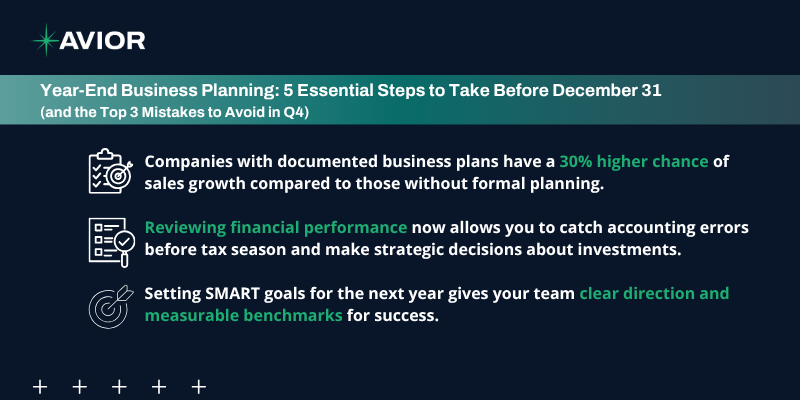Year-End Business Planning: 5 Essential Steps to Take Before December 31 (and the Top 3 Mistakes to Avoid in Q4)

The final quarter of the year arrives with a strange mix of urgency and opportunity. For business owners, Q4 represents more than just holiday parties and year-end bonuses. It’s the critical window where smart planning can set the foundation for next year’s success, while poor decisions can create problems that linger for months. The difference between businesses that thrive and those that merely survive often comes down to how they use these final weeks.
Most business owners understand they should plan for the year ahead, but knowing what to do and actually doing it are two different things. Research suggests that entrepreneurs who write formal plans are 16% more likely to achieve viability. The businesses experiencing growth are the ones making time for strategic planning before January arrives. Whether you’re closing out a strong year or working to turn things around, the actions you take before December 31st will shape your entire next year.
Key Takeaways
- Year-end business planning creates a roadmap for growth and helps you avoid repeating past mistakes from the current year.
- Reviewing financial performance now allows you to catch accounting errors before tax season and make strategic decisions about investments.
- Setting SMART goals for the next year gives your team clear direction and measurable benchmarks for success.
- The three likely biggest Q4 mistakes are rushing tax planning, neglecting cash flow planning, and failing to create or communicate plans with your team.
- Companies with documented business plans have a 30% higher chance of sales growth compared to those without formal planning.
- Working with professionals during year-end planning helps you identify tax-saving opportunities and optimize your business strategy.
Why Year-End Planning Matters More Than You Think
Year-end planning serves as both a mirror and a map. It shows you where you’ve been while charting where you’re going. Without this dual perspective, businesses tend to repeat the same mistakes year after year, wondering why growth remains stagnant.
The value extends beyond just setting goals. When you establish a clear direction for your company, every project and decision can be evaluated through the lens of whether it serves your broader objectives. This alignment keeps teams focused and resources allocated efficiently.
The Cost of Skipping Planning
Businesses that skip formal planning face measurable consequences. They’re more reactive than proactive, constantly putting out fires instead of preventing them. Without clear direction, teams work on projects that may not align with company priorities, wasting time and money on efforts that don’t move the needle.
More concerning, businesses without plans struggle to secure financing when opportunities arise. Investors and lenders want to see documented strategies and realistic projections before committing capital.
Step 1: Conduct a Thorough Financial Review
Your financial statements tell the story of your business year. Before planning forward, you need to understand the full picture of where you stand today.
Examine Your Income Statement
Review your revenue and expenses month by month. Look for patterns in your sales data. Which months were strongest? What caused revenue dips? Understanding these trends helps you plan for seasonal fluctuations and identify opportunities for growth.
Don’t just look at total revenue. Break it down by product line, service category, or customer segment. This granular view reveals which parts of your business drive profits and which might be draining resources.
Assess Your Cash Flow
Cash flow problems kill more businesses than lack of profitability. You need to know not just whether you made money this year, but whether you had cash available when you needed it.
Review your accounts receivable aging report. Are customers paying on time? If not, you may need to tighten credit policies or improve collection processes before the new year begins.
Check your accounts payable too. Paying bills too quickly can strain cash, while paying too slowly can damage vendor relationships and your credit rating. Find the right balance for your business.
Step 2: Review and Update Your Business Goals
Goals set at the beginning of the year may no longer make sense by December. Market conditions change, new opportunities emerge, and some objectives become less relevant.
Evaluate Current Year Performance
Pull out the goals you set last January. How many did you achieve? For the ones you didn’t reach, ask why. Was the goal unrealistic? Did priorities shift? Did you lack the resources to pursue it?
This honest assessment prevents you from setting similar goals next year that will meet the same fate. It also helps you recognize which goals matter most and deserve renewed focus.
Set SMART Goals for Next Year
Vague goals like “increase sales” or “improve customer service” don’t drive action. Instead, create goals that are Specific, Measurable, Achievable, Relevant, and Time-bound.
For example, replace “increase sales” with “grow revenue by 15% in Q1 through expanding our email marketing list by 500 subscribers and launching two new product bundles.” This specificity makes the goal actionable and progress trackable.
Step 3: Plan Your Budget and Major Investments
A realistic budget turns goals into reality by allocating resources where they’ll have the most impact. Without a budget, spending becomes reactive and often inefficient.
Project Next Year’s Revenue
Use this year’s performance as your baseline, but adjust for known changes. Are you launching new products? Losing or gaining major clients? Factor these elements into your projections.
Be realistic rather than optimistic. Overestimating revenue leads to overspending, creating cash flow problems down the line.
Allocate Resources Strategically
Once you know your expected revenue, decide how to invest it. Which areas of your business need more resources? Where can you trim expenses without sacrificing results?
Consider major purchases carefully. If you need new equipment or technology, buying before year-end might offer tax advantages. But don’t make purchases just for tax deductions. The item should serve a genuine business need and fit within your strategic plan.
Step 4: Address Operational Improvements
Year-end is the perfect time to streamline operations and eliminate inefficiencies that have accumulated over the year.
Review Your Technology Stack
Most businesses accumulate software subscriptions and digital tools throughout the year. Some get used daily, others sit forgotten. Audit your technology spending and eliminate tools that don’t deliver value.
Consider consolidation opportunities. Can one platform replace three separate tools? Streamlining reduces costs and makes workflows more efficient.
Update Systems and Processes
Document the processes that work well and fix the ones that don’t. If certain tasks create bottlenecks or errors, now is the time to redesign them before carrying dysfunction into the new year.
Train your team on any new systems before the busy new year begins. This prevents disruptions and helps everyone start January with confidence.
Step 5: Communicate Plans to Your Team
The best business plan means nothing if your team doesn’t know about it. Clear communication ensures everyone works toward the same objectives.
Hold Planning Sessions
Bring key team members together to review the past year and discuss plans for the next. Their insights from the front lines often reveal opportunities or challenges you might miss from a management perspective.
These sessions also build buy-in. When people help create the plan, they’re more invested in its success.
Establish Clear Expectations
Each department and team member should understand their role in achieving company goals. Break annual objectives into quarterly and monthly milestones so progress stays visible and manageable.
Regular check-ins throughout the year keep everyone aligned and allow for course corrections when needed.
The Top 3 Q4 Mistakes to Avoid
Even with good intentions, business owners often make errors during year-end planning. Avoiding these common pitfalls can save you time, money, and frustration.
Mistake 1: Waiting Until December for Tax Planning
Many businesses wait until the final weeks of December to think about taxes, discovering too late that they missed opportunities for deductions or made financial decisions that don’t optimize their tax situation.
Start tax planning in Q3, not Q4. Work with your accountant throughout the year to identify strategies for reducing your tax burden. Whether it’s timing major purchases, maximizing retirement contributions, or structuring year-end bonuses, these decisions require advance planning. Waiting until the last minute limits your options and increases the risk of costly errors.
Mistake 2: Neglecting Cash Flow Planning
Businesses often focus on profits while ignoring cash flow, but you can be profitable on paper and still run out of money. The holiday season and year-end expenses can strain cash reserves, especially when clients pay invoices slowly or customers delay purchases.
Review your cash position now and forecast your needs through Q1. Consider seasonal patterns in your revenue and expenses. If you anticipate a cash crunch, arrange a line of credit before you need it. For service-based businesses, send invoices promptly and follow up on outstanding receivables. For product-based businesses, manage inventory levels carefully to avoid tying up cash in unsold goods.
Mistake 3: Setting Goals Without Documenting or Communicating Them
Mental plans and verbal agreements don’t create accountability. Without written documentation and clear communication, goals get forgotten, priorities shift, and team members work toward different objectives.
Create a written plan, even if it’s just one page. Share it with your team and revisit it regularly. This document becomes your roadmap, keeping everyone aligned when distractions arise. Make sure each team member understands how their work contributes to company objectives. Without this clarity, effort gets wasted on tasks that don’t move the business forward.
Common Mistakes to Avoid in Year-End Planning
As you work through your year-end planning process, watch out for these common pitfalls that can undermine your efforts:
- Waiting until the last minute to start planning, leaving insufficient time for thoughtful analysis and strategic decisions
- Overlooking team input and creating plans in isolation without gathering insights from employees who understand day-to-day operations
- Setting unrealistic goals that are too ambitious or not grounded in actual business capacity and market conditions
- Failing to review the current year thoroughly before planning the next, missing valuable lessons from recent successes and failures
- Ignoring market changes and external factors that could impact your business in the coming year
- Not allocating sufficient budget for strategic initiatives, making goals impossible to achieve
- Skipping contingency planning and failing to prepare for potential challenges or economic shifts
Work With Us
Year-end business planning transforms the final quarter from a chaotic rush into a productive period that sets the stage for next year’s success. By conducting thorough financial reviews, setting clear goals, planning budgets, improving operations, and communicating effectively with your team, you create a foundation for sustained growth. Avoiding common mistakes like rushed tax planning, poor inventory management, and undocumented strategies protects you from setbacks that could derail your progress. The businesses that thrive are those that treat year-end planning as a priority, not an afterthought.
At Avior, we understand that business planning intersects with personal financial goals. Our advisors work with business owners to align company strategies with individual wealth-building objectives, helping ensure your business success translates into personal financial security. From tax-efficient strategies to retirement planning and succession planning, we help you make decisions that benefit both your business and your family’s future. Contact Avior today to schedule a consultation and discover how integrated financial planning can help you build the successful business and life you envision.
Investment management and financial planning services are offered through Avior Wealth Management, LLC, an SEC-registered investment adviser. Tax and accounting services are provided by Avior Tax and Accounting, LLC, a wholly-owned subsidiary of Avior Wealth Management, LLC.
Insurance products, including life, disability, long-term care, and annuities, are offered through Avior Insurance. Insurance and annuity products are not offered through Avior Wealth Management, LLC, and are not covered by SIPC. Avior Insurance operates independently to provide insurance solutions tailored to clients’ needs. Insurance products are subject to the terms and conditions of the issuing carrier.
All information contained herein is general in nature and is not to be construed as specific investment advice. Avior does not provide legal advice. Clients should consult their own legal, tax, and financial professionals before making any decisions. All investments involve risk, including the potential loss of principal. Past performance is not indicative of future results.
No Comments
Sorry, the comment form is closed at this time.




